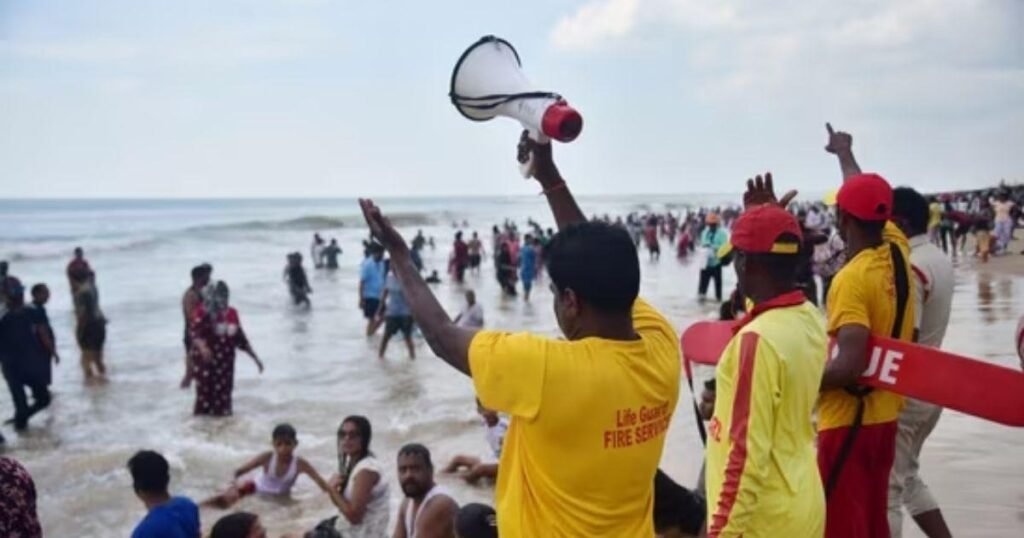Cyclone Montha is a severe tropical cyclone formed over the Bay of Bengal in late October 2025. It made its landfall on India’s east coast, bringing heavy rains, strong winds, and coastal flooding.

Cyclone Montha is highly relevant to the UPSC CSE, APSC, and other State PCS exams as it directly connects to multiple topics of the General Studies syllabus. In Geography (GS Paper I), it helps understand topics like climatology, tropical cyclones, and disaster-prone regions of India. In GS Paper III (Environment and Disaster Management), it offers a case study on the impact of climate change, early warning systems, and disaster preparedness. Additionally, questions may arise on the naming of cyclones, regional vulnerability, and mitigation strategies under the NDMA framework. For State PCS exams, such as APSC, the cyclone’s impact on coastal districts, agriculture, and livelihood is also crucial from a local geography and current affairs perspective.
Key facts about Cyclone Montha:
- It made landfall between Machilipatnam and Kalingapatnam on the east coast of Andhra Pradesh on the night of October 28, 2025
- Wind speeds at landfall were in the range of 90–100 km/h.
- It caused heavy rainfall, flooding, crop damage, infrastructure disruption, and at least one reported death.
- The name “Montha” was contributed by Thailand, and in Thai it means “a fragrant flower” or “beautiful flower.”
- The storm began as a low-pressure area over the southeast Bay of Bengal around October 24, 2025.
- It intensified into a deep depression by October 26 and further strengthened to a cyclonic storm by October 27.
- As per India Meteorological Department (IMD) forecasts, it intensified into a Severe Cyclonic Storm by October 28 before landfall.
Name origin & significance of Cyclone Montha:
- The name “Montha” was contributed by Thailand and in Thai means “fragrant flower” or “beautiful flower.”
- Cyclones in the North Indian Ocean are named by IMD (RSMC New Delhi) using a preapproved list from 13 member countries.
Geographical & Physical Dimensions of Cyclone Montha:
- Region of origin & trajectory: Montha formed in the southeast Bay of Bengal and is moved northwestwards toward the Andhra Pradesh coast.
- Affected states: Andhra Pradesh is at greatest risk. Nearby states like Odisha, Tamil Nadu, parts of Telangana, and Chhattisgarh may receive heavy rains and gusty winds.
- Storm surge & rainfall risk: Coastal areas face risk of storm surge, inundation in low-lying zones, and heavy rainfall causing flooding in interior regions.
- Physical vulnerability factors: The coastal terrain includes deltaic plains, river mouths, estuaries and agricultural belts. These zones are naturally vulnerable to coastal flooding and erosion.
What are the Socio-Economic & Human Impacts of Cyclone Montha:
- Evacuations & preparedness: Over 50,000 people were evacuated in Andhra Pradesh as Montha approached.
- Fatalities & damage: As Montha made landfall, 2 deaths were confirmed in Andhra Pradesh.
- Infrastructure & livelihoods: The storm uprooted trees, damaged power lines and houses, caused water logging and disruption of essential services in Andhra Pradesh.
- Regional spillovers: States like Odisha reported lesser damage but experienced heavy rains and disturbances.
What are the Preconditions for Cyclone Formation:
- Warm Ocean Waters (Sea Surface Temperature ≥ 27°C)
- Warm water acts as the primary energy source.
- The ocean must be at least 26.5°C up to a depth of around 60–70 metres.
- Such heat causes rapid evaporation and convection, providing the latent heat that drives cyclone formation.
- Coriolis Force (Effect of Earth’s Rotation)
- The Coriolis Effect causes the rising air to spin, leading to the characteristic cyclonic circulation.
- It is negligible at the Equator. Cyclones rarely form within 5° latitude on either side of the Equator
- Approximately, 65% cyclonic activity occurs between 10° and 20° latitude.
- Pre-existing Low-Pressure Area or Disturbance
- A tropical disturbance or low-pressure zone is the seed for cyclone development.
- Rising warm, moist air converges in this zone, intensifying the pressure gradient.
- High Humidity in the Mid-Troposphere (5–7 km altitude)
- Sufficient moisture (50% to 60%) in the middle layers of the troposphere enhances cloud formation and convection.
- It supports the continuous release of latent heat, fueling the system.
- Weak Vertical Wind Shear
- Vertical wind shear is the change in wind speed and direction with height.
- For cyclone formation, this shear must be low (< 10 m/s).
- High shear disrupts vertical development, tearing the system apart.
- Upper-Level Divergence (Outflow of Air Aloft)
- There must be divergence at the upper levels of the atmosphere, allowing air to rise from below continuously.
- This maintains low surface pressure and enhances the inflow of moist air.
Disaster Management & Policy Lessons:

- Institutional readiness: NDRF, SDRF, state disaster departments, and local authorities were put on alert ahead of Montha.
- Red alerts & evacuation: Red alerts issued in many coastal districts; thousands moved to relief camps setup in schools & government buildings.
- Relief & restoration: Post-storm efforts include restoring electricity, clearing debris, repairing houses, providing medical and essential service support.
- Learning & policy upgrade: Montha will inform future updates in the National Disaster Management Plan, State Disaster Response Plans, and strengthen multi-hazard risk mapping in coastal zones.
Conclusion:
Cyclone ‘Montha’ presents a vivid, real-time example of how cyclonic systems threaten the eastern coast of India under evolving climatic conditions. It illustrates the interplay of meteorology, human vulnerability, disaster preparedness, and policy response.
Sources:
- https://timesofindia.indiatimes.com/city/visakhapatnam/cyclone-montha-live-updates-chennai-weather-andhra-pradesh-imd-red-alert-bengal-cyclonic-storm/liveblog/124839484.cms
- https://www.indiatoday.in/india/story/cyclone-months-storm-andhra-pradesh-odisha-telangana-chennai-red-alert-rain-2808890-2025-10-27
Article List
Latest Articles
| Article Title | Read More |
|---|---|
| Top 10 UNESCO World Heritage Sites in India | Read Article |
| Special Agencies of United Nations | Read Article |
| Tiger Reserves in India | Read Article |
| Neighboring Countries of India | Read Article |
| Middle East Countries | Read Article |
| Top 10 Highest Mountain Peaks in India | Read Article |
| 10 Most Powerful Countries in the World by Military Strength | Read Article |
Cyclone Montha is a severe tropical cyclonic storm that formed over the Bay of Bengal in October 2025. It made landfall between Machilipatnam and Kalingapatnam on the east coast of Andhra Pradesh, bringing heavy rains, strong winds, and coastal flooding.
Cyclone Montha is relevant for Geography, Environment, and Disaster Management sections of UPSC, APSC, and State PCS exams. It helps candidates understand cyclone formation, climatology, disaster-prone regions, and policy response under the NDMA framework.
Cyclone Montha caused heavy rainfall, flooding, crop damage, and power disruption in Andhra Pradesh. Over 50,000 people were evacuated, and two deaths were reported. The storm also affected nearby states like Odisha and Tamil Nadu with moderate rainfall.
Cyclone Montha formed due to typical tropical cyclone conditions – warm sea surface temperatures (≥26.5°C), low wind shear, high humidity, a pre-existing low-pressure area, and Coriolis force that enabled cyclonic rotation over the Bay of Bengal.
Cyclone Montha highlights the importance of early warning systems, coastal evacuation plans, and multi-agency coordination. It reinforces the need to strengthen disaster preparedness, resilient infrastructure, and climate-adaptive policy measures in India’s coastal regions.












